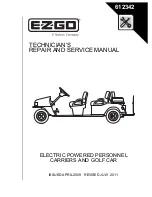
BRAKES
Bleeding the Hydraulic Brake System
6
8.
Connect an air hose to the vacuum brake bleeder. The air pressure must be regulated at 12 to 15 psi (0.827 to
1.034 Bars).
9.
Press the handle on the brake bleeder to start the vacuum.
10. With the vacuum running, open each of the top brake bleeder valves 1/4 turn on the front wheel calipers.
11. Monitor the fluid as it flows through the tubes of the vacuum bleeder tool. Continue to run the vacuum until there
are no air bubbles in the lines.
See following NOTE.
NOTE:
Do not allow the brake fluid in the master cylinder reservoir to fall below the MIN level mark at any time during
the brake bleeding procedure.
12. With the vacuum still running, tighten the two top front brake bleeder valves to 25 in-lb (3 N·m).
13. Allow the handle on the brake bleeder tool to open and turn the vacuum system off.
14. After bleeding, fill the master cylinder reservoir to the MAX level with DOT 5 brake fluid.
15. Tighten the cap on the master cylinder reservoir.
16. Properly label and dispose of the used brake fluid.
17. Inspect the brake system.
See Brake System Inspection on page 6-4.
18. Before a test drive, pump the brake pedal 3 or 4 times. Carefully drive the vehicle and test the function of the
brakes. Check the fluid level to ensure no loss of fluid.
MANUAL BLEEDING OF BRAKES ON A DOT 5 FLUID FILLED SYSTEM
Manually bleeding brakes is not done by rapidly applying extreme pressure on the vehicle’s master cylinder. It’s simply
a function of gently moving fluid through the system to displace the air and contaminants that have accumulated.
It is important to have the vehicle sitting level and safely supported on jack stands before the manual bleeding
procedure is performed.
See following WARNING.
WARNING
• Do not bleed brakes with only one end of the vehicle raised. To place vehicle on four jack stands, lift
only one end or one side of vehicle, depending on model, at a time. See Lifting The Entire Vehicle,
Section 3, Page 3-6. Use a suitable lifting device (chain hoist or hydraulic floor jack) with 1000 lb. (454
kg) minimum lifting capacity. Do not use the lifting device to hold vehicle in the raised position. Use
approved jack stands of proper weight capacity to support the vehicle.
The following procedure will enable correct bleeding:
1.
Turn the key switch OFF and remove the key. Place the Forward/Reverse switch in NEUTRAL.
2.
Check the brake pedal and master cylinder push rod for proper adjustment before the brake system is bled.
Brake Pedal Adjustment, Section 5, Page 5-15.
3.
Remove the cap from the master cylinder reservoir and top off the master cylinder with fresh DOT 5 silicone brake
fluid.
NEVER
mix DOT 3, DOT 4, or DOT 5.1 with DOT 5 as it
IS NOT
compatible.
4.
Place, but do not tighten, the cap on the master cylinder reservoir.
5.
Lift and support the entire vehicle on jack stands and remove the wheels.
See Lifting The Entire Vehicle,
Section 3, Page 3-6. See preceding WARNING.
6.
Start at the brake caliper farthest away from the master cylinder. Attach a clear plastic hose to the caliper’s
bleeder valve and place the other end into a clear container (a clean plastic 16 oz. soda bottle works fine)
filled with enough brake fluid to cover the end of the hose. This prevents air from being drawn into the caliper
during the bleeding process.
2009-2012 XRT 950 Maintenance and Service Manual
Page 6-17

































